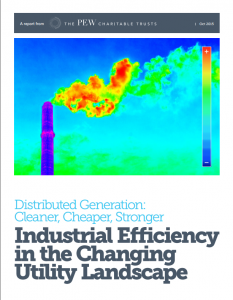Full Title: Distributed Generation: Cleaner, Cheaper, Stronger Industrial Efficiency in the Changing Utility Landscape
Author(s): Joshua Reichert and Tom Wathen
Publisher(s): The Pew Charitable Trusts
Publication Date: October 1, 2015
Full Text: Download Resource
Description (excerpt):
Electricity is illuminating, but its generation, transmission, and distribution have long been opaque. Today, however, the once static utility industry is becoming a dynamic and transformative opportunity for the nation’s economic, environmental, and energy future.
An array of technological, competitive, and market forces are changing how the U.S. generates power and the ways that Americans interact with the electric grid. A century-old centralized system is yielding to advanced, distributed-energy generation capabilities—in which power is produced at or near the place where it is consumed—that allow the industry to respond to new market opportunities and evolving consumer desires.
At the root of this evolution are years of flat electricity demand—the result of efficiency improvements; expanded, cost-effective, clean, and efficient generation options; changing expectations for energy infrastructure, such as an increased priority on reliability and security; and enhanced standards for controlling pollutants. These behavioral and economic shifts are driving the nation toward cheaper, cleaner energy sources and a decentralized fleet of power generators with growing competition. They also are putting pressure on businesses and policymakers to adapt to the evolving marketplace.
Distributed generation is not a passing fad, and new technologies pose significant challenges to long-standing business models. Utilities at the forefront of adoption and innovation are pursuing business and regulatory changes that will allow them to embrace and prosper in a new, less centralized future. At the other end of the spectrum, some utilities are trying to preserve the traditional model. And in the middle, the balance of the utility sector, also referred to in this analysis as the utility industry, is striving to understand and work with changing conditions. As the established industry struggles to modernize, more recent entrants to the sector—from solar energy and efficiency service companies to telecommunications and home security firms—are offering new goods and services in the electric marketplace.
